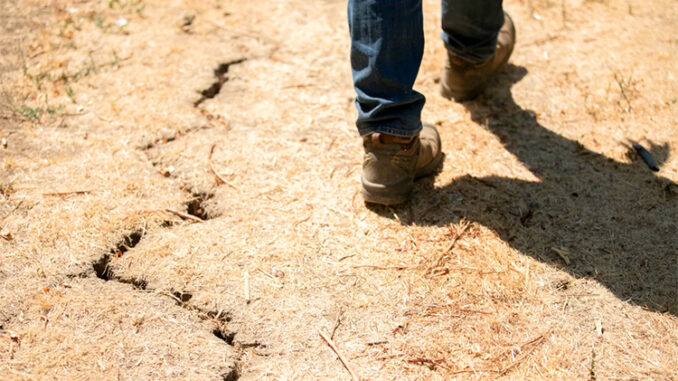
There’s a hive of PhDs at the University of California at Davis who are working to reinvent food production in the Golden State. Researchers have fanned out across the globe collecting rare plant samples; others are grafting Frankenstein trees and stitching together root systems of plums and peaches to create better almond and walnut trees.
Some scientists are deconstructing crime scenes of withered and dying plants, gathering clues about what killed them. Others deprive trees of moisture or douse them with salty water, stress-testing the plants to understand how much they can withstand at experimental fields, including one that researchers callTorture Orchard.
Whether in a sterile lab or in a dusty farm row, these projects are focused on one objective: saving water. In the midst of California’s extreme drought and scant water available for growers, the name of the game is how to produce more crop per drop.
With about 70,000 California farms operating on drastically reduced water rations, experts say it’s past time to figure out how to turn down the tap.

LESSONS LEARNED: DROUGHT THEN AND NOW
A CalMatters series investigates what’s improved and what’s worsened since the last drought — and vividly portrays the impacts on California’s places and people.
Researchers are applying lessons learned from the last drought to enable the $50 billion agricultural sector to sustain itself in a new reality, where water use will not be dictated by state or federal regulators, but by nature and climate change.
“It was a huge challenge for all farmers,” said Josette Lewis, chief scientific officer for the Almond Board of California, which represents the industry. “People in California agriculture recognize that, with the need to manage groundwater more sustainably and the uncertainty of surface water supply, the overall footprint of agriculture may change.”
Because agriculture uses four times more water than California’s residential users, growers are under pressure to tighten their water budgets. This year, many have lost their water from the drought-plagued Sacramento-San Joaquin Delta watershed as well as their federal allocations, and are increasingly reliant on depleted groundwater stores.
And, while the last drought took three years to peak, this drought has already reached a dire state in its second year; nearly 90% of California is experiencing extreme drought.
“This is different from the last drought. What’s changed is how fast things are happening,” said Sam Sandoval Solis, an associate professor at UC Davis and a cooperative extension specialist who advises farmers on efficient water management.
“The reality is we have reached a point we are using more water than is available in California,” he said. “This is nothing new. We’re living beyond our means. It breaks my heart.”
“People in California agriculture recognize that…the overall footprint of agriculture may change.”
Josette Lewis, the Almond Board of California
The growing water crisis in California is reverberating through what used to be a slow-to-change industry. In the same way that workers across the national economy have had to learn new skills and adopt complex technology, farmers and ranchers have also felt the ground move beneath them. Many of the old ways of doing things are no longer working, and not all of the crops they grow make sense against a backdrop of recurring droughts.
To help them cope, California farmers have been turning to science and technology. Some tools only recently gained widespread traction, such as satellite and drone technology and soil moisture sensors that measure the evapotranspiration of an orchard — how much water trees pull from the earth and how much is exhaled into the atmosphere.
But growers have run out of quick, easy solutions. Transformative methods to reduce their water footprint are slow in coming. Many research projects to engineer drought-resistant crops won’t see fruition for decades because fruit and nut trees need more than 20 years to mature.
Growers say they already have had some success: From 1980 to 2015, California farmers cut their water use by 14% while increasing productivity by 38%, according to the California Farm Water Coalition. (State officials have not yet released more recent data.) Urban water use, however, has dropped at a much faster pace: Each person on average used about 35% less in 2015 than in 1980.
Despite almost back-to-back droughts, some growers are planting more acres of high-value tree crops that require year-round irrigation, putting more stress on the water supply. As the world market for almonds exploded, growers have ramped up planting. California’s overall orchard acreage has steadily increased from 2.8 million in a dry 2007, to 3.1 million at the onset of the last drought in 2012, to 3.6 million in 2017, at the drought’s end.
Many orchard growers are resorting to digging more and deeper wells, adding to the state’s groundwater crisis.
In an almond orchard near Modesto, siblings Christine and Erich Gemperle are trying to find drought-resistant solutions that work in their sometimes dry, salty soil.
Keep tabs on the latest California policy and politics news
By clicking subscribe, you agree to share your email address with CalMatters to receive marketing, updates, and other emails from the site owner. Use the unsubscribe link in those emails to opt out at any time.
The Gemperles, experimenting with efficient irrigation technology and new almond breeds, are among the many growers who hope to survive, even prosper, in a drier California. Working with researchers is not just an act of virtue, it’s borne of the will to survive: Their federal water allocation was cancelled this year.
The state is invested, quite literally, in helping growers lessen their water needs. Karen Ross, California’s secretary of agriculture, said her department has handed out more than $80 million since 2014 helping convert farms from flood irrigation to micro-irrigation.
“We have taken a page from Israel in using precise amounts of water at the precise time,” Ross said. “It’s making a huge difference and will help our farms remain sustainable.”
Building crops for a drier California
Farm science used to mean a farmer kicking the dirt with the toe of a boot to determine soil health. Adaptive technology meant a new attachment for the John Deere. Today farming involves WiFi-connected orchards, smartphone apps controlling irrigation schedules and embedded sensors monitoring soil moisture.
One test for tree crops, developed at UC Davis, works something like a blood-pressure cuff. Now an industry standard with different versions available to growers, the so-called pressure bomb device essentially monitors the moisture levels in a tree’s miniature plumbing system, said Ken Shackel, a professor of plant sciences at the university.
Shackel devised his own water test method by putting a tree’s leaves under pressure and observing how much water is forced out. It’s a way of understanding a tree’s water needs in real time, allowing growers to find the smallest drink it needs. He’s worked with walnuts, prunes, grapes and almonds, learning the precise time to add or withhold water.
“We are asking a plant to produce the same while giving it less water,” Shackel said. “They need to learn there’s no such thing as a free lunch. It’s about finding the right balance.”
It’s up to the plant geneticists, the breeders, as their colleagues call them, to painstakingly build a better crop for California — fruits and vegetables that can withstand not just the current drought but the inevitably-drier future.
“We are asking a plant to produce the same while giving it less water. They need to learn there’s no such thing as a free lunch.”
ken shackel, UC Davis
Sometimes that means traveling to places in the world, such as Iran and Afghanistan, where trees are adapted to little water and salty soils. Those mother plants would then become the basis for a new generation of tree that can thrive in California’s hotter climate.
Pat J. Brown, a UC Davis associate professor who is a nut crop breeder, selects varieties for low-water requirements and indifference to saline soils. At the Torture Orchard, Brown and his colleagues fed pistachio trees increasing amounts of salty water. Scientists were delighted that their work did not kill a single tree, suggesting that growers someday may be able to use briny water, not just scarce fresh water, to irrigate orchards.
In another test, a selection of pistachio trees has not been watered since May. It’s another success, measured by a simple mercy: The trees managed to live.
“They may not look great,” Brown said, “but they are still alive.”
Tapping a living repository of the world’s trees
The Hail Mary solution to growing during a severe drought may come from a nondescript tract, tucked into a part of California that lets you know you are in farm country: Tomatoes and other produce lie squashed on the sides of the road, having sloshed off hauling trucks rumbling down two-lane roads.
The Wolfskill Experimental Orchards outside Davis, home to the National Clonal Germplasm Repository, is a treasure for California agriculture. The farm is a kind of living, botanical Smithsonian, a lending library where researchers can check out rare plants, study past research and conduct breeding trials.
The repository, operated jointly by UC Davis and the U.S. Department of Agriculture, is a way to preserve the samples for future generations of growers, said Kendra Baumgartner, a plant pathologist at the facility.
“The plant’s ability to sustain in drought has become a top priority,” she said.
Included in the orchard are almond and pistachio specimens collected from the Fertile Crescent in the Middle East and stout pomegranate trees from Turkmenistan. It is from this ground, researchers say, that the next drought-tolerant commercial nut or fruit tree will emerge.
A small almond grove set aside for research has been left in survival-of-the-fittest mode since 2004. The trees are the least-fussy at the facility: They are being dry-farmed, meaning they survive only on what moisture falls from the sky.
The gnarled trees produce a small, blonde nut, the favorite of Tom Gradziel, a Davis professor of plant science and an almond breeder. Gradziel walks through the orchards the way farmers do, reaching out to pluck fruits and nuts, checking them and absently snacking as he goes.
His recent work is challenging: finding a better-producing almond tree than the mighty nonpareil variety that has dominated California production since it was introduced in the 1880s. Its popularity is owed, in part, to the tree’s ability to survive drought. But what was once thought to be excellent drought tolerance is — in today’s hotter-drier-longer world — no longer enough.
Like most orchard trees, almonds are grafted onto the rootstock of other trees, such as plums and peaches, to search for better varieties. Gradziel has spent two decades tweaking and refining those varieties in order to land on the almond of the future.
“Breeding takes a lot of patience,” he said. “I’m planning now for trees that growers will have in 20 years. You can’t rush this.”
Almonds, California’s most-thirsty crop, were cast as the bogeyman during the last drought. About 1.3 million acres of almonds are under cultivation this year, according to the Almond Board. It’s been on a steady rise, drought or no drought.
The industry has been on the offensive, pushing back against the oft-quoted “one almond requires one gallon of water” equation and noting the nut’s protein value and its shell’s use as cattle feed and other purposes.



Be the first to comment